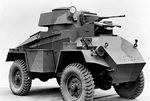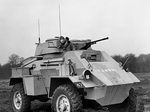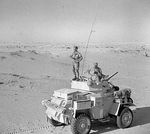Humber Armored Car
| Country | United Kingdom |
| Manufacturer | Rootes Group |
| Primary Role | Armored Car |
Contributor: Alan Chanter
ww2dbaseNumerically, the Humber was the most important British armoured car in World War II, with a total of 5,400 vehicles being manufactured.
ww2dbaseIn October 1939 the Rootes Group were contracted to undertake the design and production of a new car which was needed urgently to fill a shortfall in Armoured car production. To save time, Rootes decided to utilise an existing design, the Guy Armoured Car (based itself on a a pre-war wheeled light tank design by Guy Motors of Wolverhampton), and marry its body shape to a chassis that they were already constructing for the Karrier KT4, being manufactured by one of their subsidaries, as an artillery tractor for the Indian Army. By utilising only well-tried components this presented the Rootes factory with very few difficulties in building the new armoured vehicle. The only major changes to the existing chassis required was the moving of the 90hp Rootes 6-cylinder petrol engine to the rear and the strengthening of the suspension. Despite production being undertaken at Karrier Motors Ltd of Luton, the name Humber (another Rootes Subsidary) was chosen in order to avoid confusion with various other military vehicles already known as "carriers".
ww2dbaseThe mechanical side of the Humber was relatively unadventurous; solid axles with half-elliptic springs were used, and the engine and transmission were ex-civilian truck units. Like most British-produced armoured vehicles of the time, the Humber was rugged, reliable and operationally sound. The only defect reported in service being a short engine life.
ww2dbaseWith a three-man crew the Humber was used extensively in the North African campaign from 1941 onwards. Service experience with the Mark I soon suggested that a few improvements would be beneficial, and consequently a Mark II version began rolling off the production line. This was basically similar to the Mark I but included a cleaned-up front end, incorporating the driver's visor in the glacis plate, and a revised radiator intake.
ww2dbaseThe Armoured Car, Humber Mark III, which entered production in 1942 had a more roomy turret than the Marks I and II, which allowed the crew to be increased to four. The first three Marks of Humber Armoured Car all had an armament of two Besa machine-guns, one of 7.92mm calibre and the other of 15-mm. The latter was never an entirely satisfactory weapon, being prone to stoppages, and in the Humber Mark IV Armoured Car the American 37-mm gun was introduced in its place. Because this reduced the turret space available the crew was reduced to three.
ww2dbaseThe Humber was particularly liked as a command vehicle (despite being severely outgunned) since it had more internal room than the alternative Daimler armoured car. They were used by both armoured car regiments (where they tended to be used at regimental and squadron headquarters if Daimlers were also available) and reconnaissance regiments (of infantry divisions) in most theatres of war in which British and Commonwealth troops were engaged until 1946.
ww2dbaseVariants included a special radio carrier, known as Rear Link vehicle, which was fitted with a dummy gun, and an anti-aircraft version fitted with a special machine gun mounting.
ww2dbaseThe Humber gave excellent service, and was still being used by some armies in the Far East well into the early 1960s.
ww2dbaseSources:
The Illustrated Encyclopaedia of Military Vehicles (Ian V Hogg & John Weeks,-Hamlyn, 1980);
Armoured Fighting Vehicles (Philip Trewbitt, Dempsey-Parr, 1999)
Tanks and other Armoured Fighting Vehicles 1942-45 (B. T. White, Blandford Press, 1975)
Tank Battles in Miniature (Donald Featherstone, Patrick Stephens ltd, 1977)
Last Major Revision: Sep 2009
SPECIFICATIONS
Mk I/II
| Machinery | One Rootes 6-cylinder gasoline engine rated at 90hp |
| Suspension | Wheel, 4x4 |
| Armament | 1x15mm Besa machine gun, 1x7.92mm Besa machine gun |
| Armor | 15mm front, 15mm turret, 10mm sides, 10mm rear |
| Crew | 3 |
| Length | 4.57 m |
| Width | 2.18 m |
| Height | 2.38 m |
| Weight | 7.0 t |
| Speed | 40 km/h off-road; 72 km/h on-road |
| Range | 220 km off-road; 400 km on-road |
MK III
| Machinery | One Rootes 6-cylinder gasoline engine rated at 90hp |
| Suspension | Wheel, 4x4 |
| Armament | 1x15mm Besa machine gun, 1x7.92mm Besa machine gun |
| Armor | 15mm front, 15mm turret, 10mm sides, 10mm rear |
| Crew | 4 |
| Length | 4.57 m |
| Width | 2.18 m |
| Height | 2.38 m |
| Weight | 7.0 t |
| Speed | 40 km/h off-road; 72 km/h on-road |
| Range | 220 km off-road; 400 km on-road |
Mk IV
| Machinery | One Rootes 6-cylinder gasoline engine rated at 90hp |
| Suspension | Wheel, 4x4 |
| Armament | 1x15mm Besa machine gun, 1x7.92mm Besa machine gun |
| Armor | 15mm front, 15mm turret, 10mm sides, 10mm rear |
| Crew | 3 |
| Length | 4.57 m |
| Width | 2.18 m |
| Height | 2.38 m |
| Weight | 7.0 t |
| Speed | 40 km/h off-road; 72 km/h on-road |
| Range | 220 km off-road; 400 km on-road |
Photographs
 |  |  |  |
Você gostou deste artigo ou achou este artigo útil? Se sim, considere nos apoiar no Patreon. Mesmo USD $1 por mês já vai longe! Obrigado. Por favor, ajude-nos a espalhar a palavra: Fique atualizado com WW2DB: |
Visitor Submitted Comments
10 Apr 2020 11:43:34 AM
My mother worked in the casting department of the Humber factory in Coventry during the war. She had no photos of her work, and would not talk about her wartime life. Thanks to this site I now know what she helped to build.
All visitor submitted comments are opinions of those making the submissions and do not reflect views of WW2DB.
- » Wreck of M-49 Found (10 Apr 2025)
- » Japanese Emperor Visited Iwoto (Iwo Jima) (8 Apr 2025)
- » Race, Holocaust, and African-American WW2 Histories Removed from the US Naval Academy Library (7 Apr 2025)
- » US Government Plans to Purge WW2 Information (17 Mar 2025)
- » Ver todas as notícias
- » 1,167 biographies
- » 337 events
- » 44,606 timeline entries
- » 1,243 ships
- » 350 aircraft models
- » 207 vehicle models
- » 376 weapon models
- » 123 historical documents
- » 261 facilities
- » 470 book reviews
- » 28,500 photos
- » 365 maps
James Forrestal, Secretary of the Navy, 23 Feb 1945
Por favor, considere nos apoiar no Patreon. Mesmo R$1 por mês já faz uma grande diferença. Obrigado!
Ou, por favor, nos apoie adquirindo alguns produtos do WW2DB na TeeSpring. Obrigado!
23 May 2011 10:53:45 AM
May I correct your information regarding the parentage of the Humber Armoured Car. It was designed in 1938 by Guy Motors to meet a War Office contract which specified rivetted construction. Guy Motors did not like the idea of rivetts flying about inside the body if it was hit by a shell, so they said they would, at their own expense, try to construct a welded armoured body, which thw War Office said could not be done! They succeeded. After intial trials, the War Office wanted further large quantiites, which due to existing commitments with military vehicles, they felt Guy Motors fellt they could not supply. They turned the jigs for building the body and details of their patented construction over to Humber without cost and allowed other tank manufacturers to use their patented armour welding information as well without charge. In 1953, they were awarded a token sum of £5,000 for allowing others to use this patent which saved a considerable number of lives and the country, money.